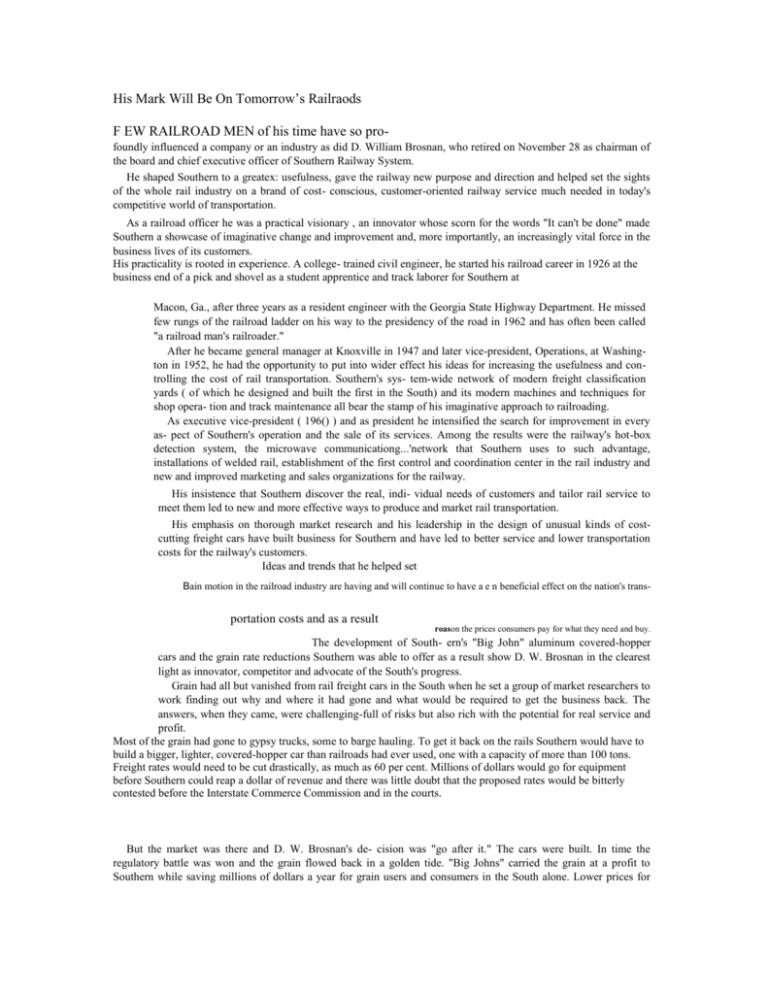bros_text - SOUTHERN Railfan
advertisement

His Mark Will Be On Tomorrow’s Railraods F EW RAILROAD MEN of his time have so profoundly influenced a company or an industry as did D. William Brosnan, who retired on November 28 as chairman of the board and chief executive officer of Southern Railway System. He shaped Southern to a greatex: usefulness, gave the railway new purpose and direction and helped set the sights of the whole rail industry on a brand of cost- conscious, customer-oriented railway service much needed in today's competitive world of transportation. As a railroad officer he was a practical visionary , an innovator whose scorn for the words "It can't be done" made Southern a showcase of imaginative change and improvement and, more importantly, an increasingly vital force in the business lives of its customers. His practicality is rooted in experience. A college- trained civil engineer, he started his railroad career in 1926 at the business end of a pick and shovel as a student apprentice and track laborer for Southern at Macon, Ga., after three years as a resident engineer with the Georgia State Highway Department. He missed few rungs of the railroad ladder on his way to the presidency of the road in 1962 and has often been called "a railroad man's railroader." After he became general manager at Knoxville in 1947 and later vice-president, Operations, at Washington in 1952, he had the opportunity to put into wider effect his ideas for increasing the usefulness and controlling the cost of rail transportation. Southern's sys- tem-wide network of modern freight classification yards ( of which he designed and built the first in the South) and its modern machines and techniques for shop opera- tion and track maintenance all bear the stamp of his imaginative approach to railroading. As executive vice-president ( 196() ) and as president he intensified the search for improvement in every as- pect of Southern's operation and the sale of its services. Among the results were the railway's hot-box detection system, the microwave communicationg...'network that Southern uses to such advantage, installations of welded rail, establishment of the first control and coordination center in the rail industry and new and improved marketing and sales organizations for the railway. His insistence that Southern discover the real, indi- vidual needs of customers and tailor rail service to meet them led to new and more effective ways to produce and market rail transportation. His emphasis on thorough market research and his leadership in the design of unusual kinds of costcutting freight cars have built business for Southern and have led to better service and lower transportation costs for the railway's customers. Ideas and trends that he helped set Bain motion in the railroad industry are having and will continue to have a e n beneficial effect on the nation's trans- portation costs and as a result roason the prices consumers pay for what they need and buy. The development of South- ern's "Big John" aluminum covered-hopper cars and the grain rate reductions Southern was able to offer as a result show D. W. Brosnan in the clearest light as innovator, competitor and advocate of the South's progress. Grain had all but vanished from rail freight cars in the South when he set a group of market researchers to work finding out why and where it had gone and what would be required to get the business back. The answers, when they came, were challenging-full of risks but also rich with the potential for real service and profit. Most of the grain had gone to gypsy trucks, some to barge hauling. To get it back on the rails Southern would have to build a bigger, lighter, covered-hopper car than railroads had ever used, one with a capacity of more than 100 tons. Freight rates would need to be cut drastically, as much as 60 per cent. Millions of dollars would go for equipment before Southern could reap a dollar of revenue and there was little doubt that the proposed rates would be bitterly contested before the Interstate Commerce Commission and in the courts. But the market was there and D. W. Brosnan's de- cision was "go after it." The cars were built. In time the regulatory battle was won and the grain flowed back in a golden tide. "Big Johns" carried the grain at a profit to Southern while saving millions of dollars a year for grain users and consumers in the South alone. Lower prices for feed grains as a result of reduced transportation costs are already spurring great growth in the South's livestock industry and Southern has set up a new department of ~gri-Business Services to help encourage further expansion. His philosophy of lower rates based on heavier car- loadings was extended to tobacco, cotton, lumber, furniture, coal and many other commodities. As early as 1960, Southern introduced the unit-train principle to railroading for the low cost movement of coal from mines to power generating plants-with whole trains of high-capacity aluminum gondola cars called "Silver- sides." More and more of these unit train movements are being established, on Southern and other railroads. A native of Georgia and a gr.aduate of the Georgia Institute of Technology, D. W. Brosnan has an intense interest in the progress of his native region. It shows in the moves he made to strengthen Southern's efforts in the field of industrial development and to have Southern purchase thousands of acres of well-located land to preserve for industrial use. It is evident in his active concern for better education at all levels to produce tomorrow's leaders for the South's business and industry. He serves on advisory committees for several universities and in recent years Southern has established scholarships at three southern universities. A new spirit is abroad in the railroad industry-a competitive vigor, a dedication to increased usefulness to customers and an awareness of the obligation to pro- vide transportation cost savings for the public where that is economically possible. Many have felt over the years that they recognized D. W. Brosnan's hand in it. Fortune magazine hailed him as a railroader who asks only the right to compete-"and means it." Readers of Modern Railroads named him "Railroad Man of the Year" in 1963 as having done the most for the railroad industry. Sales and Marketing Executives International hondred him as "National Salesman of the Year" for all industry .Business Week magazine spbt- lighted Southern's chief with a cover story on innova- tions in cost-cutting freight cars and improved services. Modern Metals magazine named him "Man of the Year" as the one who "rode herd" on Southern's "revolutionary aluminum car program." Phi Sigma Kappa Fraternity designated him "Phi Sig of the Year" because of "his outstanding contributions to industry and to the public." In unprecedented two-in-a-row wins in 1963 and 1964, Southern received the "Golden Freight Car" award, the railroad "Oscar" presented annually by the Railway Progress Institute for the most effective pro- motion of railroad freight tra@c. These awards came in recognition of Southern's pioneering in the use of lightweight, high-capacity a1uminum-body covered hop- per cars to reduce drastically the freight rates for grain and its "program of saving railroad customers money through custom-tailored transportation designed to bring traffic back to the rails, penetrate new traffic markets, and make the railway of even gre~er useful- ness to shippers and receivers and the general public." He has received honorary degrees from Clemson University in Sbuth Carolina, Mercer University in Georgia and the University of Chattanooga in Tennes- see. Freedoms Foundation, Inc., awarded him the "George Washington Medal of Honor" in 1965 for "outstanding achievement in bringing about a better understanding of the American Way of Life." Always an eloquent advocate of individual initiative and enterprise tempere~ by a regard for the public's good, D. W. Brosnan worked to make Southern Rail- way a skilled and eager competitor, and to win com- petitive freedom for all common carriers to strengthen them and the nation's transportation system. Certainly he will retain an active interest in Southern's progress as a director of the company, but he has relinquished active leadership of the company to trusted hands. And he did it with the insight of a man who knows from experience the pressure of new ideas and the drive to see them brought to early realization. As he told a newspaper reporter not long after his retirement was announced : "I do think 65 is a good " retirement age-for the company and for the young men who need more opportunity to advance and to put their ideas into effect." . Talking with guests during a tour of the completed $30 million tunnel clearance and track relocation project on Southern's CNO&TP line in 1963, D. W. Brosnan shared with them his interest in the constant reshaping of the railroad to meet the needs of its territory. During his years as chief executive, he strengthened Southern's system physically and competitively and expanded its road mileage to more than 10,000 with the acquisition of the Central of Georgia Railway and other lines.






